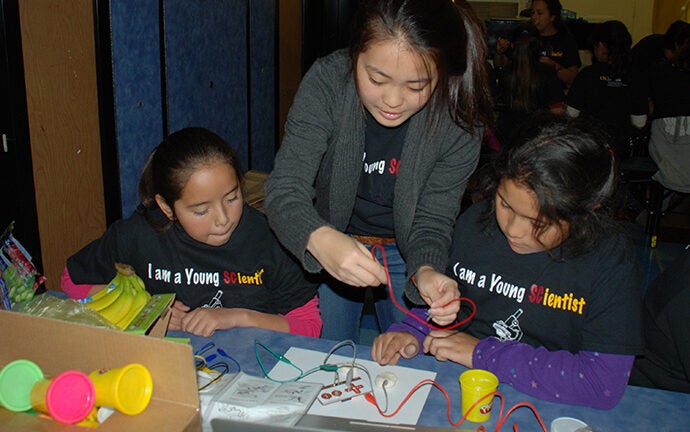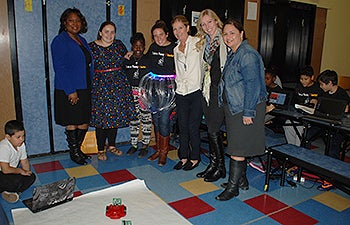
Making science cool for kids
Sporting a black USC Dornsife Young Scientists Program T-shirt, fourth grader Lea Stevenson was proudly clutching her first-ever flash drive — a gift to each student who participated in the computer workshop organized by the Joint Educational Project’s (JEP) Young Scientists Program (YSP). On the drive was the holiday card she had just finished creating using Scratch, a basic computer programming language. Stevenson was brimming with enthusiasm.
“It was so cool —I chose a bedroom background, then I added a ballerina and a cat and put a birthday cake on top of the bed,” she said with a grin, adding that she would like to study science at USC when she grows up, “because it’s one of the smartest schools.
“Science is really cool once you get used to it,” she added. “It may be a bit hard when you first try it, but the more you try, the easier and more fun it gets.”
Stevenson was one of 50 fourth- and fifth-grade students from Lenicia B.Weemes Elementary School who participated in the Nov. 17 after-school computer science studio workshop. Located near USC’s University Park campus, Weemes is one of five community schools from USC Family of Schools to benefit from YSP.
In addition to creating holiday cards, students learned how to write computer code, design games, and control robots through instructions sent wirelessly from a computer. They also listened to a talk by simulation supervisor Claudia Chung Sanii from Walt Disney Animation Studios who explained how she uses computer science to create realistic clothing and hair movement for many of the students’ favorite animated characters.
Awakening curiosity through play
On hand to help the budding young scientists were YSP teaching assistants, or TAs. Among them was Alison Kamikawa, a junior majoring in health promotion and disease prevention at Keck School of Medicine of USC.
“This is a program we put on for the Weemes’ students to help them learn more about computer science and technology,” Kamikawa said. “Our work as YSP TAs is to expose them to different STEM curricula and present it in a way that’s really fun for them so it will awaken their curiosity about these subjects.”

Weemes Elementary students enrolled in JEP’s YSP enjoy learning about Scribbler robots with the help of graduate students in computer science from USC Viterbi School of Engineering.
At one station, Weemes students played computer games using MaKey MaKeys, a program board that overrides keyboard keys, enabling the youngsters to substitute any conductive substance — in this case, bananas, modeling clay or pencil drawings — for computer keys.
At another station, students created wearable electronics. Frowning with concentration, fifth grader Ramon Ruiz was carefully sewing a felt bracelet using conductive thread.
“I’m making a bracelet and when you complete the circuit and click it, it lights up,” explained Ruiz, adding his ambition was to become a singer and a scientist. “Today I was using the computers to make my own games with MaKey MaKey. I didn’t understand it at first, but I got used to it. I feel I’m really learning how to use computers. Now I want to join the robotics club at school so I can learn how to make robots.”
USC Viterbi School of Engineering’s computer science faculty member Sheila Tejada, collaborated with YSP to create the event. At another station, a group of her graduate computer science students helped kids wirelessly control bright red Scribbler robots via computers as the robots sketched out geometric patterns.
Breaking down gender stereotypes over STEM
“This hands-on event is promoting under-represented youth, especially in computer science,” said USC JEP STEM Programs Manager DJ Kast, who designed and organized the event with Tejada’s help. “It also addresses the gender gap issue of women in computer science.”
Kamikawa said she was delighted to see how many girls were participating in the workshop. “Girls often think STEM is for boys,” she said. “They don’t think about STEM careers for their own future so it’s really thrilling to see girls here today getting excited about science and technology and start thinking about that for themselves.”
JEP donor and USC Marshall School of Business alumna Cindy Winn agreed. “It’s wonderful to see how many girls are here today. You can see their faces light up,” she said as she visited the event, with her daughter Kate, an alumna of USC Annenberg School for Communication and Journalism. “It’s lovely to see how the students are learning from the kids and the kids are learning from the students and being inspired. Their camaraderie is really nice.”

Admiring the Scribbler robots are, from left, JEP executive director Tammara Anderson; USC JEP STEM Programs Manager DJ Kast; Shamyia Bray, a fourth grade Weemes Elementary School participant; YSP TA Claire Chatinover; USC alumna and donor Cindy Winn; her daughter, USC alumna Kate Winn; USC Viterbi School of Engineering’s Sheila Tejada.
For many students, the highlight of the event was the talk by Chung Sanii, whose Disney credits include recent Oscar-winning features Big Hero 6, Frozen and the upcoming Zootopia. She spoke to students about careers in computer science and how she uses her skills as a computer scientist in her animation work with Disney. There, she oversees the team responsible for building character effects in films — including fur, which must reflect the motion of real fur; tailored cloth, which moves according to real-life physics; and body dynamics, which introduce muscle and fat movement to help make the weight and size of the characters appear realistic.
Chung Sanii used pieces of velvet and cotton to demonstrate how material moves in different ways and showed students clips of some of their favorite animated characters. Prior to Disney, Chung Sanii spent 10 years at Pixar Animation Studios, where she worked on Oscar-winner Brave as simulation supervisor. Using animated images of Merida, she also explained the physics behind creating the feisty Scottish princess’ curly red mane.
Learning about how Merida’s clothing and hair were animated using computer science was “really cool,” Stevenson said.
(Math + science) – fear = success
Roshaun Gendrett, Title I coordinator at Weemes, said students at the school love YSP.
“Without this program, many of them probably wouldn’t have a chance to experience the kind of hands-on training they’re getting here today,” he said. “On behalf of our principal Lynn Brown, we want to thank USC Dornsife for holding this computer workshop here on our campus. We are very grateful.”
Tammara Anderson, executive director of JEP, said YSP’s most important mission is to help kids overcome any fear of science or math and to see STEM subjects as something that occur naturally in their everyday life.
“When they’re not afraid they soak everything up like sponges,” she said. “They become excited about school. So that’s our job — to make STEM subjects exciting for them so they want to delve deeper into those disciplines. Then when they get to college they’ll be ready to go, they won’t be afraid.”